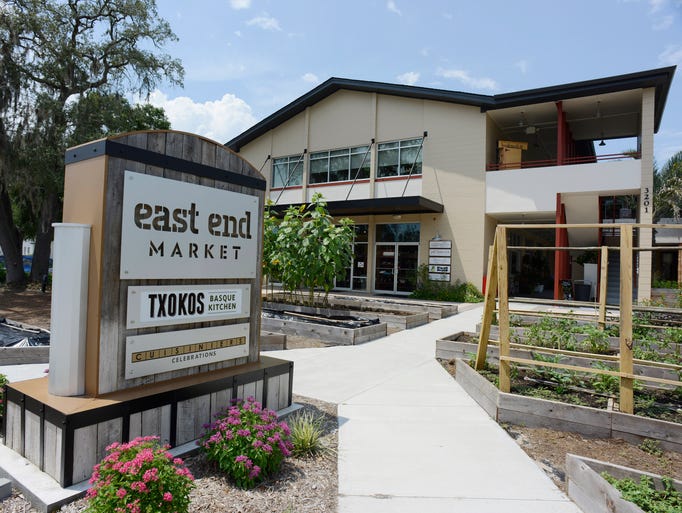By Sarah Sekula; Published on usatoday.com
Food courts aren’t what they used to be. Forget cafeteria-style meals, bad lighting and unappealing decor. Urban food courts of today, often called food halls (because that just has a better ring to it), will wow you with local delicacies, food-focused learning and carefully planned entertainment, all with an international flair. Some feature big-name chefs, others feature up-and-comers, but one thing is certain: they put a ton of culinary choices all under one roof, and people can’t get enough of ’em.
“I think their popularity stems from the way food halls provide a place for community interaction to take place,” says John Rife, owner of East End Market in Orlando. “Most patrons don’t just rush in for a grab-and-go item, instead they tend to linger and mingle with other market goers. In this way I see these food halls as the physical embodiment of the Slow Food movement, reminding us that food should be savored and shared as a community.”
The Barlow in Sebastapol, Calif.
This super stylish Northern California food hall is located in a former apple cannery. The grand plan: to connect customers not only with products and the people who make them, but also with the production itself. Simply put: It’s the “new Sebastapol,” with all the delights of the Napa area in a more low-key, approachable setting. You’ll find wine tasting rooms, farm-to-table and snout-to-tail foods, and a bakery offering princess cakes and gelato. In fact, it’s worth a trip for the gelato alone. Even the landscaping is edible; the sidewalks are framed with planter boxes of produce, and there’s an in-ground garden at the back of the property, featuring fresh fruits, herbs and veggies. thebarlow.net
East End Market in Orlando, Fla.
When urban farmer John Rife sports his thinking cap, good things happen. The proof? East End Market. Tucked away in the the trendy Audubon Park Garden District, this cozy nook is home to a dozen merchants, including a bookstore, restaurant and baking accessories shop. Plus, there’s a demo kitchen where you can learn everything from pie-making to improving your knife skills and a garden out front where you can get some dirt under your nails. Start the day with a house-brewed Kombucha at the juice bar, hop over to Kappo to sample sushi and an Okinawan spinach salad (straight from the garden), and grab a loaf of artisan bread to go from Olde Hearth Bakery Co. where the Belgian chocolate mango cherry sourdough is to die for. Beyond the chowing down, there’s a slew of learning opportunities like yoga classes, dining etiquette lessons and book clubs. eastendmkt.com
Grand Central Market in Los Angeles
This food hall is not a newcomer. In fact, it’s been alive and kicking since 1917. However, it went through a major revamp in 2013 adding new vendors, updated decor and longer hours. It’s the quintessential mix of old L.A. and new and rounds up the perfect combo of cultures, too. It’s home to a spectacular array of stalls ranging from cheesemongers to ice cream makers. Try the fizzy hoppy tea (sparkling tea with the hoppy taste of beer) at upscale coffee shop G&B Coffee; it’s a crowd-pleaser. And if you have a hankering for the popular cheesy egg sandwiches from Eggslut, be prepared for a Disneyland type of line (the wait is up to an hour on weekends). And the Belcampo Burger is something to get excited about. The 5.5-ounce beef comes from a Wagyu-Angus blend and is topped with cheddar and caramelized onions. grandcentralmarket.com
The Plaza Food Hall in New York City
Strawberry lemonade cupcakes? Check. Chocolate banana mille crepes? Check. Gold-sprinkled cake pops? Check. The Plaza Food Hall, an expansion of the popular Todd English Food Hall, certainly has the sugary confections covered. After satisfying your sweet tooth, move on to The Plaza Roll, made up of tuna, salmon, yellowtail, avocado, asparagus, cucumber and spicy sauce, or the Tartine Périgourdine (which you can only get at this food hall). Served on sourdough, it’s a filling meal of smoked duck, goat cheese and salad. Don’t forget a walnut cream croissant to scarf down later (it’s baked on the spot). theplazany.com
The Source in Denver
The fact that this European-style artisan food market and retail space is housed in an iconic 1880s ironworks building should tell you something: this place has character. Plus, it’s in the trendy River North Art District (known by locals as RiNo, pronounced rhino), home to furniture makers, photography studios and art galleries galore. Inside The Source, you’ve got 25,000 square feet worth of mouthwatering nibbles. There’s a French bakery, a gourmet cheese and spice shop, a liquor store offering private wine lockers, a brewery that serves Belgian sour beers (which Denverites rave about) and a cantina specializing in Mexican street food. thesourcedenver.com
Union Market in Washington, D.C.
With 40 local artisans under one roof, it’s easy to get your foodie fix in a flash. Located in the up-and-coming NoMa neighborhood (the heart of the city’s industrial food industry), it’s jam packed with everything from barrel-aged vinegar to cranberry-orange bread. Must-tries include: fish, in the form of gravlax sandwiches, creative salads grown hydroponically on the rooftop garden and the gin-and-tonic salmon. Check the schedule for special events like Sunday suppers, ice cream festivals and drive-in movies. unionmarketdc.com

